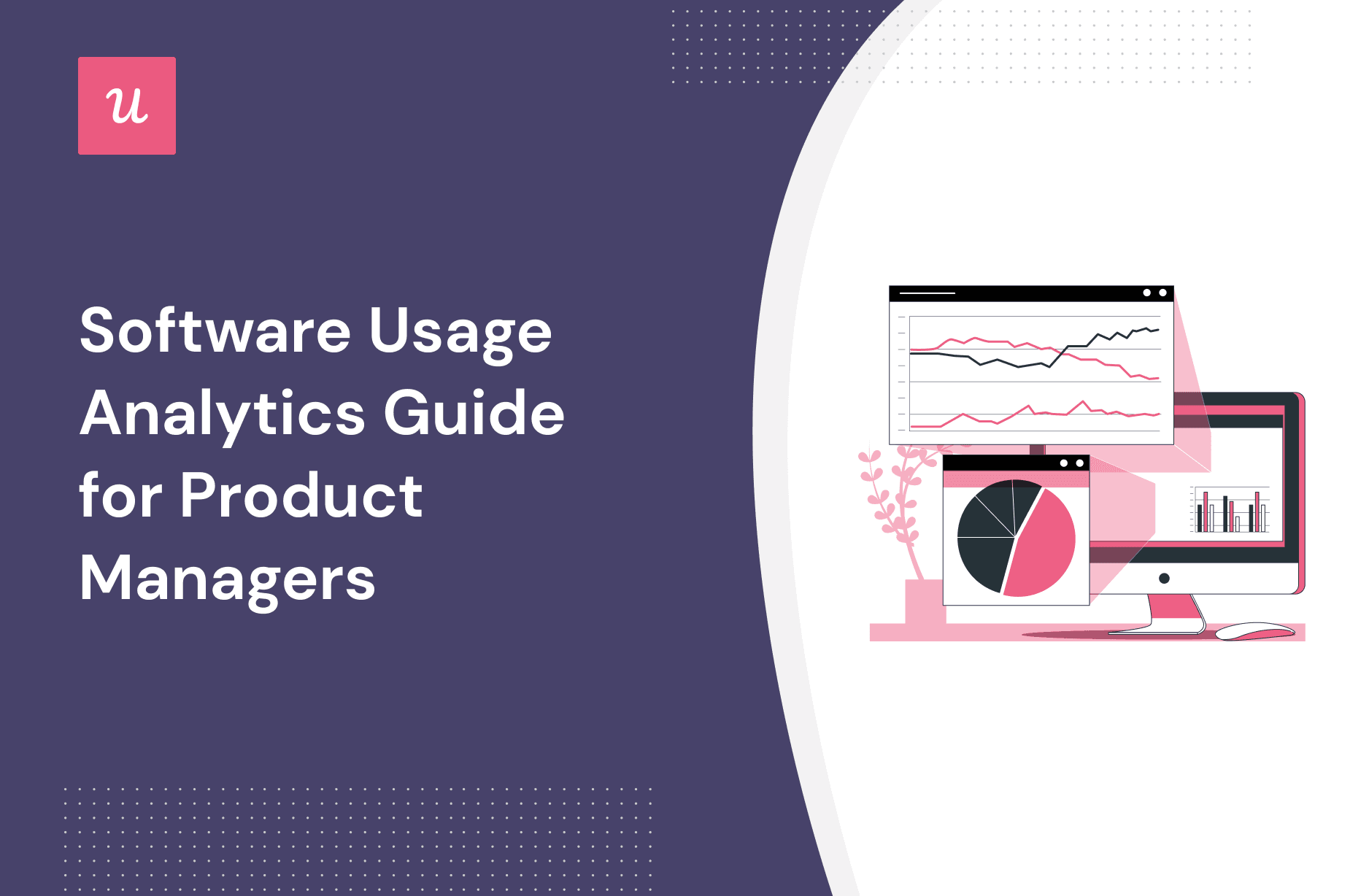
Data is power. Any savvy product manager should be looking at how they can leverage software usage analytics to make more informed decisions and boost product growth.
In this article, we’re going to unpack exactly what usage analytics is, why you should care about it, how to use it in your product, and the best tools for the job.
What are you waiting for? Let’s get started!
Try Userpilot Now
See Why 1,000+ Teams Choose Userpilot

Summary of software usage analytics
- Software usage analytics is the process of capturing, analyzing, and utilizing data on how users interact with your product.
- There’s a common misconception that marketing analytics and product usage analytics are the same. Marketing analytics is primarily focused on external data and metrics related to customer acquisition. Product usage analytics is far more focused on internal measures (i.e., in-app user behavior).
- Product managers are busy people. Is it worth spending time on product usage analytics? Yes because firstly, it helps improve the quality of your product decision-making. Secondly, you can use software usage analytics to reduce friction. To top it off, product analytics will help you drastically improve user experience.
- As a product manager, you have two primary methods of gathering information about in-app user behavior: asking users directly through surveys or interviews (expensive and time-consuming) or software usage analytics.
- How do you go about setting analytics up within your own product? Start with a clear goal, choose the metrics you’re going to measure, gather data from a variety of places, conduct detailed analysis, and implement what you find with targeted in-app communication.
- Of course, none of this is possible without the right tool for the job. There are many options out there on the market, but Userpilot is a powerful platform offering the perfect balance of features (analytics, in-app communication, and customer feedback) at an attractive price.
How does software usage analytics differ from traditional marketing analytics?
Which metric gives you the best insight into whether users are actually experiencing value?
Once analytics identify a friction point, what is the most effective way to fix it?
Turn usage data into better product decisions.
Userpilot helps you track behavior and instantly act on it with code-free in-app experiences.
What is software usage analytics?
Software usage analytics (sometimes referred to as product usage analytics) describes the process of capturing, analyzing, and utilizing data on how your users interact with your product.
There’s an enormous amount you can learn from product usage analytics:
- Which of your features are the most popular
- Feature ‘stickiness’
- The impact on different segments
- Friction points and drop-off points
- Information on hypotheses you’ve explored with A/B testing
That barely scratches the surface, but it’s important not to get overwhelmed by the detail. Put simply, it’s about tracking your users as they use your product.
Product usage analytics vs marketing analytics
There’s a common misconception that marketing analytics and product usage analytics are one and the same thing. On the contrary, there are clear distinctions.
Marketing analytics primarily focus on external data and metrics related to customer acquisition, inbound marketing channels, website attribution, and engagement with your community. Google Analytics is a massively popular tool in this space.
Product usage analytics is far more focused on in-app user behavior and engagement.
Here’s the rule of thumb: think external versus internal.
Why is it important to track product usage data?
Product managers are busy people. Why is it worth spending your time on product usage analytics? Here are a few key factors to consider:
- Improve decision-making. How can you make informed decisions without the right insight? Software usage analytics helps you adopt a fact-based, data-driven mentality – and that’s the best way to inform your decision-making and prioritization.
- Reduce friction. If you don’t know where your users are getting stuck, you can’t do anything about it. Use analytics to identify friction points in the customer journey and focus your efforts on removing them.
- Boost user experience. Analytics provides a whole host of valuable insights into how users interact with your product. Harness this data to make improvements throughout your app and drastically enhance the user experience.
How can PMs monitor in-app user behavior and user engagement?
As a product manager, you have two primary methods of gathering information about in-app user behavior and engagement.
- The traditional approach: reaching out directly to users. Whether you’re conducting customer interviews, gathering feedback from surveys, or running focus groups, this is a proven way of collecting valuable data. However, it’s costly and time-consuming, and you always run the risk of bias bleeding into the process.
- The modern approach: software usage analytics. Quantifiable, hard data on feature engagement, user behavior, and more.
How to conduct product usage analysis in your SaaS?
Next, we’ll break down exactly how to explore software usage data in your own product.
Define goals behind analyzing product usage data
A famous quote from author Simon Sinek is “Start with why.”
This is good advice in the product world, too!
Beginning with an idea of where you want to end up – the reason you want to conduct software usage analysis – gives you a much higher likelihood of succeeding in your goals.
Let’s say you want to increase retention. That will inform and direct all your efforts.
Different goal-setting frameworks, like OKR or the Golden Circle framework, can be used to determine your objectives.
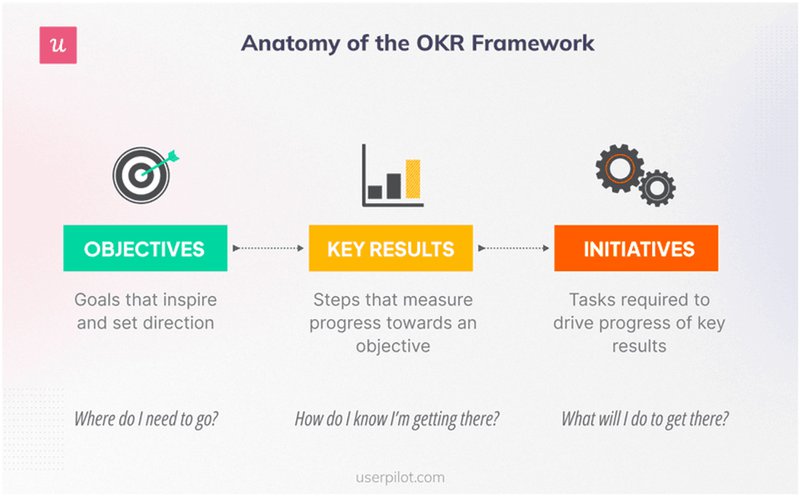
Choose the right product metrics
Here are some of the key metrics to measure. Remember, metrics are different from analytics. Analytics deals with collecting and analyzing data, whereas metrics focus on evaluating a company’s success.
- Activation rate. The proportion of users who’ve been activated (i.e., experienced value). It is calculated by dividing activated users – as you’ve defined activation – by the total signed-up users during a time period.
- Adoption rate. This gives you an idea of your overall product adoption (i.e., the percentage of users regularly using your product).
- Feature usage rate. This figure gives you an idea of feature adoption (i.e., the percentage of users regularly using a given feature).
- Customer engagement score. This composite metric will help you understand how users really feel about your product: how engaged are they, and how likely are they to keep paying for your services?
- Daily active users or monthly active users. A useful proxy for overall product stickiness, tracking this metric will help you figure out whether you’re doing a good job of keeping users engaged and retained.
Select data collection sources and gather customer usage data
You’ve set the direction, and you’ve worked out which metrics to track. Fantastic! Next, you need to think about gathering data. Here’s how you do it.
Events and feature tracking
Both event analysis and feature tracking can help you better understand user behavior. In a nutshell, you can tag important events, features, and milestones in the customer journey to track how users are interacting with them (or not, as the case may be).
What makes this particularly useful is the ability to dive deep by segmenting the data of distinct user personas (remember your users are not one homogenous group).
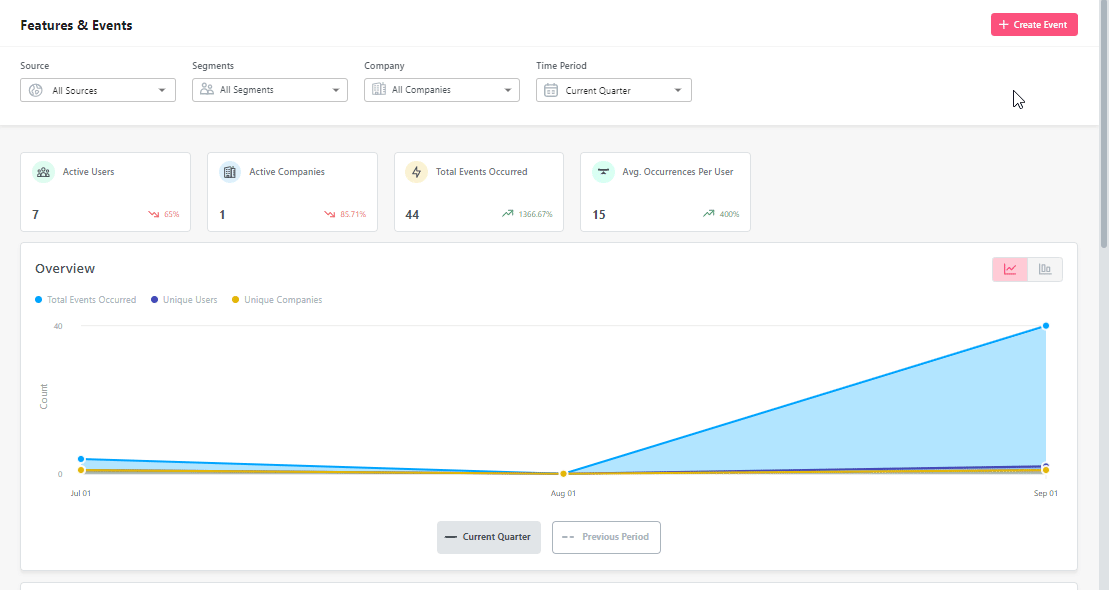
Heatmaps
A heatmap is a visualization (using colors) that demonstrates how users are interacting with your UI. They show clear evidence of which parts of your product your users engage with.
There are many types of heatmaps: feature click maps, hover maps, eye-tracking maps, and scroll maps. They are all useful for product teams – and can help them make targeted improvements – but must be considered carefully.
Remember, sometimes understanding which features are ignored is the most valuable data: it’ll indicate which features you can retire.
Session recordings
Session recordings allow you to re-watch a recording of your users interacting with your product. You’ll be able to see what features they’re using, how they navigate through your product, and potential areas of friction.
Because of the replay factor, you can gather by far the most detail of any of these options: each time you re-watch you’ll learn something different!
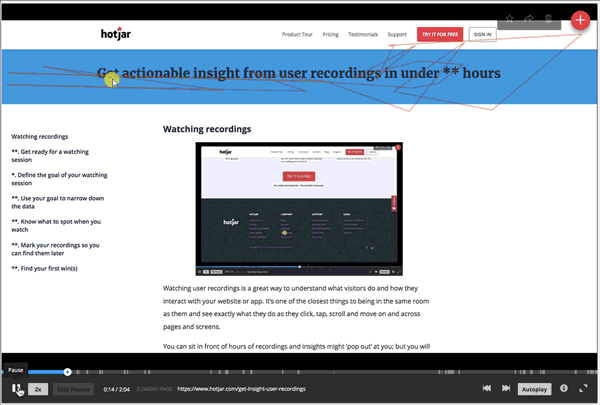
Analyze data collected and identify usage patterns amongst different user segments
As we’ve discussed, your users aren’t one homogenous group. Look into the data you’ve collected with a critical eye: are there themes and patterns you can identify amongst distinct user groups?
There are various types of analysis you can conduct – it’ll all depend on the goal you’ve set.
- Customer journey analysis. What are the primary drop-off and friction points you can identify as a user progresses along their journey?
- Milestone analysis. How many users are reaching key milestones (as you’ve defined them) throughout your product?
- Retention analysis. Are you doing a good job of holding on to your existing users?
- Churn analysis. How many users are leaving your product in a given time period?
Implement findings through in-app communication
Once you’ve analyzed and acted on user data, make sure you’re doing a good job of communicating with your users about what features you offer and how they help.
It could be that the reason behind low adoption is simply that your users aren’t aware of what’s possible – luckily, that can be easily rectified. Userpilot makes it simple to build in-app walkthroughs to boost feature adoption.
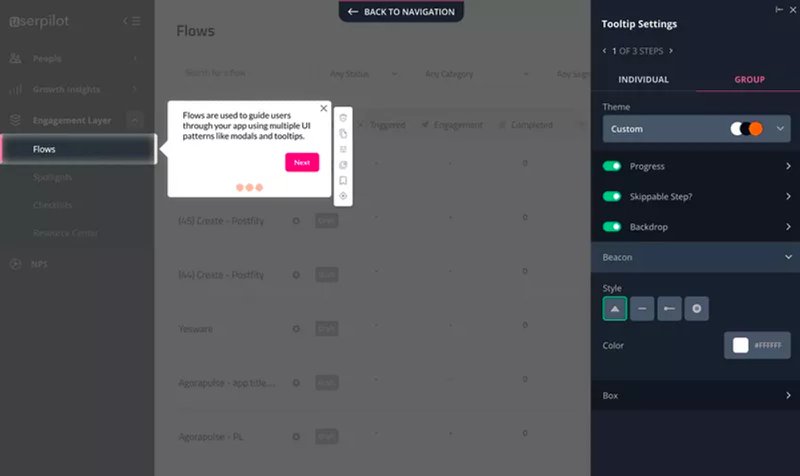
The best software usage analytics tools for SaaS companies
It’s simply impossible to generate any kind of product usage analytics without the right tool for the job. There are many great options on the market… but which is the best?
Here’s a handy guide to some of the main contenders.
Userpilot – Ultimate product analytics and engagement tool
Userpilot is a comprehensive digital adoption tool. It will help you quickly analyze user behavior, gather customer feedback, and boost product engagement with in-app and mobile experiences.
Key features include:
- Advanced segmentation. Dig deep into distinct user groups (whether that’s according to their role, demographics, jobs to be done, or some other classification) and tailor the experience accordingly.
- Event tracking and feature tagging. Define custom events and tag important features necessary to ensure your users are on the path to success.
- UI and UX patterns. Engage your users with modals, tooltips, in-app interactive messaging and guides, slideouts, and more.
- Native mobile SDK. Create targeted onboarding flows using slideouts, carousels, and push notifications without writing extra code.
- Integrations. Leverage powerful integrations to advanced product analytics tools like Heap and Amplitude.
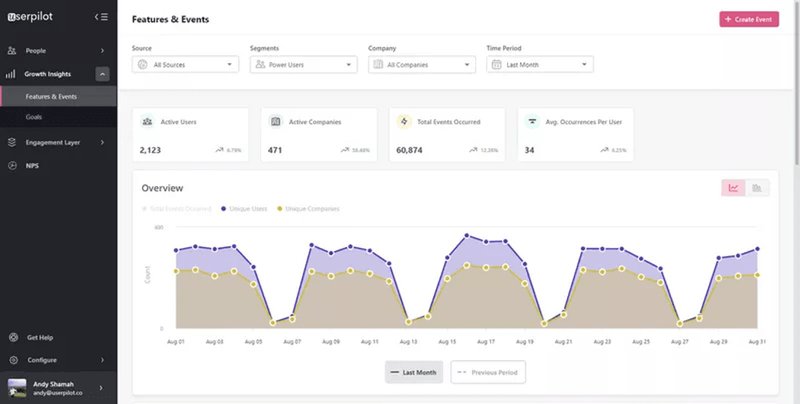
Amplitude – Standalone product analytics tool
Amplitude is another product analytics tool that can help you gather a whole host of data from your users – and transform that information into something meaningful.
You can use Amplitude to identify:
- Which features are the most heavily engaged with
- How users are navigating through your product
- Areas to strengthen to improve retention
One of the reasons Amplitude is so highly rated by its users is the ease of use: it doesn’t have a steep learning curve, but instead provides a whole host of guidance and tutorials.
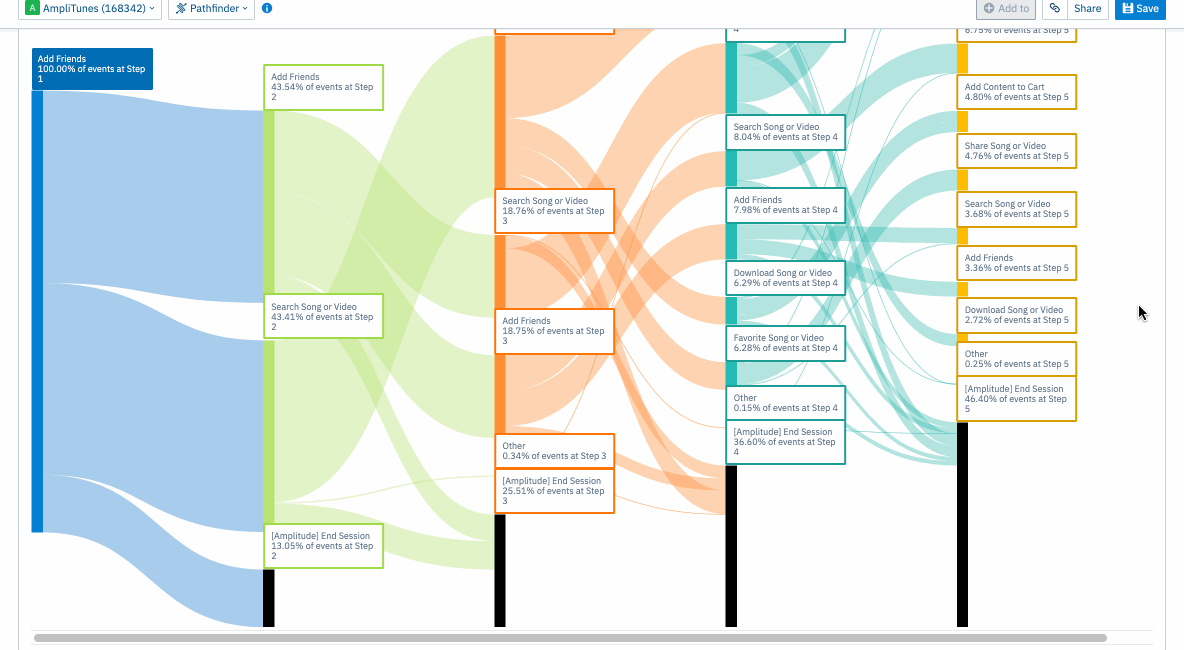
Hotjar – Qualitative user behavior tool
Hotjar is another excellent tool for a more granular and in-depth analysis of the in-app behavior of your users. It has a slightly different focus from some of the other tools on the market, offering two major features: heatmaps and session replays.
As we discussed earlier, heatmaps are visual representations of user engagement. The warmer the color of the spot on the screen, the more popular the feature is.
Session recordings are replays of what users do. You can watch user interactions to identify friction points and focus your development efforts.
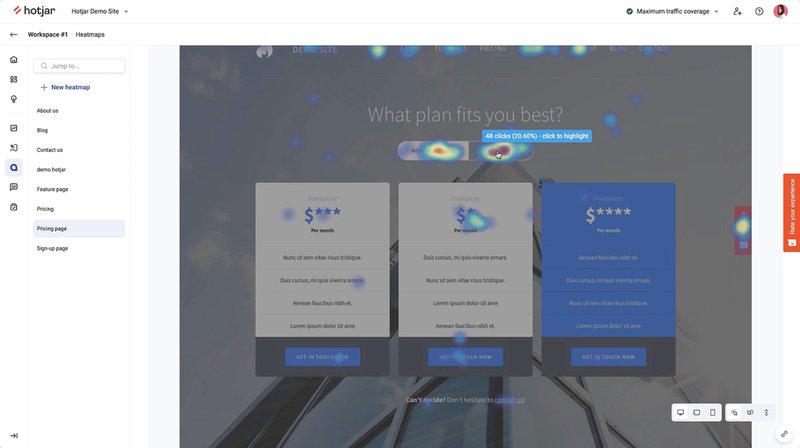
Conclusion
We’ve covered a lot of ground!
Hopefully, you now have a solid understanding of the software usage analytics landscape – from what it is, to how it’s conducted, to choosing the right tools to carry it out within your own product or service.
Want to build product experiences code-free and analyze in-app user behavior? Book a demo call with our team and get started! Check out the banner below for more details.







